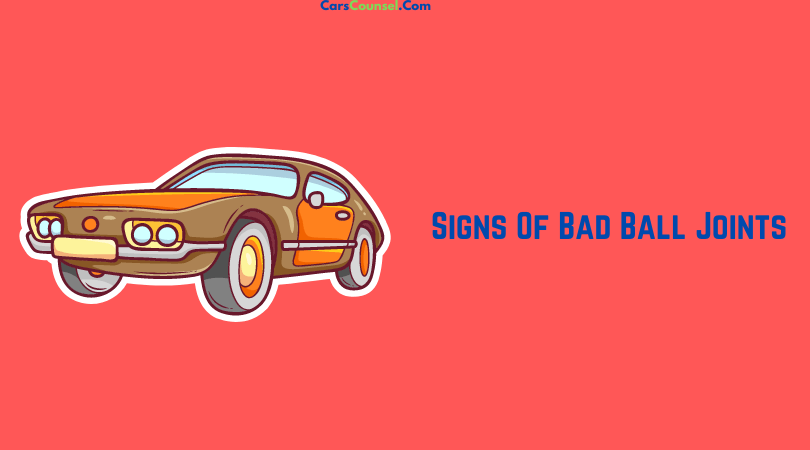Quick Navigation
Bad Ball Joint Symptoms And How To Check Them
Before going to the part about why ball joints wore out and what are the signs of bad ball joints, let’s understand the basics first.
Ball joints are a crucial component of a car’s suspension. They are the connecting link between the steering knuckles and the control arms. A ball joint has a casing that contains a socket and balls. They are important because they let the steering knuckles stay attached while it moves.
There are two kinds of ball joints; upper and lower ball joints. The main difference between the two is that the lower ball joints are load-bearing while the upper ball joints are not.
Moving forward….
Each ball joint can cost around $100, and add an additional $100 for the labor charges. The pricing can vary on the type of vehicle, like replacement in luxury cars or trucks would probably be higher. Whatever the vehicle, there will be clear signs of ball joint bad symptoms. Having knowledge of those signs will always come in handy.
The ball joints can go bad sooner or later, depending on the type of ball joints and driving location. There might be several questions buzzing in your mind around bad ball joints. Please keep reading to get answers for the signs of bad ball joints, when to replace them, and much more.
Why Do Ball Joints Wore Out?
Ball joints wear out for a variety of reasons. These joints are housed within a lubricated shell that enables the balls to move effortlessly. However, when contaminants such as dirt, grime, or other particles infiltrate the shell, the efficiency of the ball joints diminishes.
Traveling over uneven terrains may cause the shell to crack, thereby letting these contaminants in and causing the ball joints to wear out. The lubricants encapsulated within the ball joints may also seep out, and without them, the joints won’t glide as seamlessly as before. Additionally, rust is another enemy of ball joints.
Despite being constructed from robust metals, rust, brought about by external conditions, can gradually wear away at the shell of the ball joint. Furthermore, the simple act of driving leads to constant stress on the ball joints, which can eventually cause the spherical elements within the joints to loosen.
This is why they reach a stage where replacement becomes necessary. Such occurrences render the ball joints frail, influencing the vehicle’s steering and suspension capabilities.
Therefore, it’s crucial to recognize the appropriate time for ball joint replacement.
Know When To Replace The Ball Joints
The ball joints come into action whenever a car is driven. They are an active part of the car’s suspension; hence more the car is driven, the sooner the ball joints will wear off. As already said, the ball joints are made of a socket and ball that fit snugly in a lubricated case.
When a car has reached a certain distance, the closely packed ball inside the socket can become loose because of its constant movement. After the ball joints become loose, the movement of the ball joints will become intense. If the ball joints keep getting loose, it can lead to more issues in the car.
Hence, this is when ball joints need to be replaced. To avoid severe damage in the car, there are ball joint bad symptoms you can look for. Some of them are easily noticeable and can help you avoid dangerous situations that can occur from bad ball joints in the car.
Interesting Read – Temporary Fix For Bad O2 Sensor | The Ultimate Guide
6 Possible Signs Of Bad Ball Joints
After reaching a certain point, ball joints need to be replaced. It helps to maintain the smooth functioning of the suspension. When constant wear and tear, ball joints become loose, and if you drive mostly on rocky and bumpy roads, its lifespan becomes even shorter.
Below are six possible signs of bad ball joints that will let to know when it’s time to replace them.
Different Noises
Sounds can tell you a lot about your car’s health. When your car’s ball joints wear out, it’ll start making different noises like squeaks, clunks, or grinds.
As time goes on, these noises get louder and happen more often. You’ll notice these strange sounds when turning the car or driving over bumps.
They usually come from the front or side of the car. This happens when the rubber seal around the ball joints gets weak, letting dirt and other stuff get into the joints. When this happens, the joints can’t move as well, causing them to squeak.
Uneven Tire Wear
Another clue that your ball joints might be having trouble is if your front tires are wearing out unevenly. Often, this is something you might not notice. But if the ball joints are the issue, you’ll see certain wear patterns on the tire.
If the ball joints are acting up, the front tires may wear out more inside or outside.
That’s because the steering and suspension are moving more, which makes the tires wear out quicker. The reason for the uneven wear, or patchy spots on the tires, is that the loose ball joints are moving up and down a lot in the socket.
Problems With Steering Wheel
Bad ball joints can mess up how your steering wheel works. When ball joints wear out and get loose, it can make your steering feel stiff. That means it’s harder to turn corners smoothly.
It can also mess up how sharply you can turn the car. When the ball joints start wearing out, it also affects how quickly the steering and wheels respond to each other.
You’ll notice that the steering felt nice and tight when the ball joints were in good shape. But now, with the ball joints wearing out, you have to turn the steering wheel more before the wheels start to turn.
Wear Indicators
This one is the easiest to look for among all other signs of bad ball joints. The indicators could be different for older and newer car models. In new car models, the ball joints have to wear indicators letting you know when the ball joints will reach the wear limit.
However, in older cars, there’s no such indicator light. Instead of a wear indicator, there is a pin or a grease fitting used as a wear indicator. The wearing rate of both ball joints and the pins that stick out of the ball joints are the same.
So, when you see no pin sticking out of the ball joints, it means the ball joints have reached their limits.
Vibrating Steering Wheel
Your steering wheel can give you a good idea of when the ball joints are wearing out. Besides feeling stiff when parking or noticing that the wheels don’t respond quickly, there are other signs you can look out for.
Usually, when driving on a bumpy road, your car will shake a bit.
But if your ball joints are loose, your steering wheel might shake even if you drive on a flat, straight road. Cars aren’t supposed to shake on a smooth road. But if the ball joints are loose, they can wobble around in their socket, making the steering wheel vibrate.
And as the condition of the ball joints worsens, and the ball joints loosen even more, the whole car can vibrate.
Difficulty In Driving Straight
The steering also has good control when the ball joints are in good condition. But when the ball joints lose effectiveness, keeping the car in a straight alignment becomes tough.
It means the car can drift right or left when it goes over a speed bump. It is hard to drive straight because the ball joints are loose and affect the steering. However, if the car’s alignment changes when you intend to drive straight, the issue could arise from the tires.
Engaging Read – Car Overheating When AC is On | Problem Solved!
How To Check For Bad Ball Joints?
If you notice any ball joint bad symptoms, there are a few steps you can take to check the condition of ball joints. It can take up to 2 hours to inspect the suspension. Do a visual test and drive test to examine the ball joints.
There are a few safety measures you should take to be safe. Inspect safely, avoid traffic, and wear protective gear like mechanic gloves and glasses. Always use jack stands to hold the vehicle, and don’t rely on the jack to keep the car up.
Required Tools
Here are some tools you’ll need to check the ball joints.
- Torch
- Jack stands
- Jack
- Flathead screwdriver
- Wheel chocks
- Lug Wrench
Here’s How To Check Ball Joints:
[su_table responsive=”yes” fixed=”yes”]
| Step | Instructions |
| 1 |
Take your car for a drive. Pay attention to steering feel, wheel response, and general movement. Look out for unusual noises or vibrations, particularly when driving over bumps.
|
| 2 |
After driving, inspect your car visually. Ensure the car is turned off and parked in a well-lit, safe location. Use a flashlight if needed.
|
| 3 |
Lift your car safely using a car jack, and jack stands. Check your front tires closely for signs of uneven wear, which could indicate problematic ball joints.
|
| 4 |
Grab hold of the wheel and shake it. If there are any popping or grinding noises or if the wheel moves as you shake it, there may be an issue with the ball joints.
|
| 5 |
Remove the wheel. Use a screwdriver to examine where the ball joints connect to the steering knuckle and lower control arm. Pay attention to any unusual vibrations or movements which could suggest a bad ball joint.
|
[/su_table]
FAQs
What is the average lifespan of ball joints?
The material and composition of the ball joints limit their lifespan. Ball joints are made of steel which can deteriorate with rust. Other than the material, the lifespan of ball joints also depends on other factors.
Generally, the lifespan of ball joints is between 70,000 to 150,000 miles. The road’s condition will strongly determine which range your car’s ball joints will reach. If the car is driven mostly on straight and well-constructed roads, you can easily expect them to reach 150,000.
However, if the road you drive on is full of bumps, potholes, and turns like in rural areas, then ball joints can last to 70,000 miles.
Is it okay to drive a car with bad ball joints?
It is hazardous to drive a car that has bad ball joints. The ball joints can damage other car parts more when they come loose. It can also cause extreme vibration, or you can lose control of the car if the ball joints come off ultimately.
Hence, when you notice ball joint bad symptoms, you should take the car to the mechanic and get it checked. Attending to the issue at the first indication of bad ball joints is always advised.
Conclusion
That is my take on ball joint bad symptoms. Modern or older cars all give signs and indicators you’ll notice when the car has bad ball joints. The proper condition of ball joints is important because it jeopardizes the safety of the driver and others on the road.
Bad ball joints cause harm to other integral components of the suspension as well. While the cost of replacing ball joints is not much, but the price to fix the major damages caused due to bad ball joints can burn a hole in your pocket.


